12/III 2003 [46-50]46)
Another look at The Vinyl Frontierby Glen E. Swanson Monday, March 23, 2020
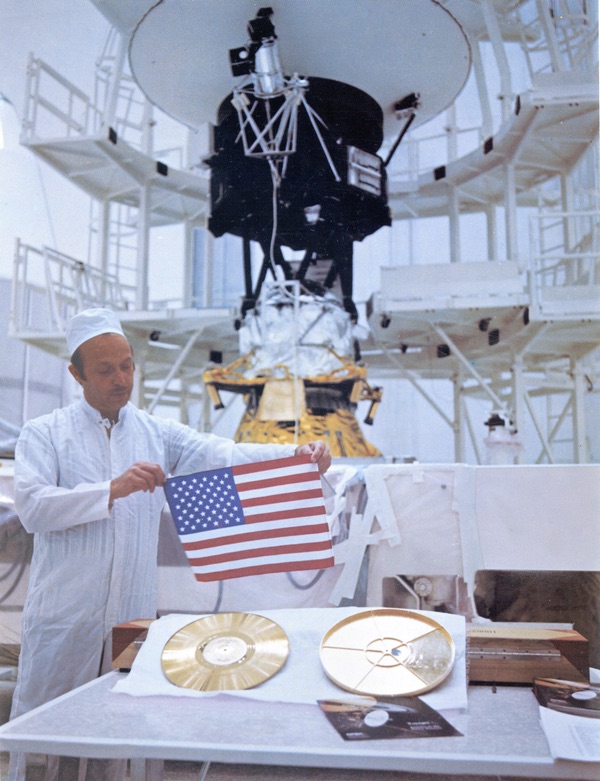 Voyager mission project manager John Casani with the Voyager record, its cover, and a small American flag to be carried by the spacecraft. (credit: NASA/JPL-Caltech)
Voyager mission project manager John Casani with the Voyager record, its cover, and a small American flag to be carried by the spacecraft. (credit: NASA/JPL-Caltech)Recently TSR ran a brief review on Jonathan Scott’s book (see “Review: The Vinyl Frontier”, The Space Review, March 9, 2020). Glen E. Swanson wrote the following review which originally appeared in the Vol. 26, No. 4 2019 issue of Quest.
1977 was the year Star Wars premiered. Late that summer, as kids waited to watch Luke Skywalker take down the Death Star for the nth time before summer vacation came to a close, a twin set of robotic probes launched into space.
https://www.thespacereview.com/article/3902/147)
Magnificent isolation: what we can learn from astronauts about social distancing and sheltering in spaceby Deana L. Weibel Monday, March 23, 2020
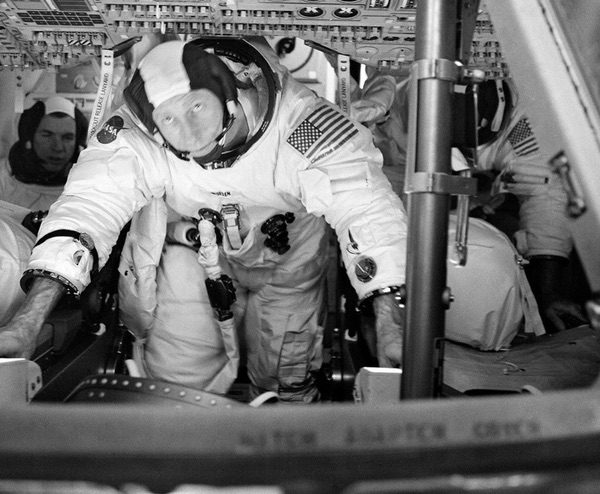 Apollo 15 astronaut Al Worden, who passed away last week, experienced a unique kind of isolation as he circled the Moon alone. (credit: NASA)
Apollo 15 astronaut Al Worden, who passed away last week, experienced a unique kind of isolation as he circled the Moon alone. (credit: NASA)The emergence of the novel coronavirus and its associated disease, COVID-19, has led to a global pandemic and a call for individuals, in the name of overall public health and an attempt to prevent national medical systems from being overwhelmed with too many patients at once, to self-isolate, self-quarantine, and practice social distancing. Many of us are confronted, for perhaps the only time in our lives, with an uncertain span of time in solitude.
Although this is the first time we’ve seen this particular phenomenon, social distancing isn’t a new invention. Humans have always had good reasons to withdraw from society, often for the greater good. Among the champions of isolation and social distancing are astronauts and cosmonauts—including the late Al Worden—whose time in space has often been spent in extended periods of cramped loneliness, away from family and friends. They can serve as inspiration in these difficult times.
https://www.thespacereview.com/article/3903/148)
Capsule on fire: An interview with Robert Seamans about the Apollo 1 accidentby Dwayne A. Day Monday, March 23, 2020
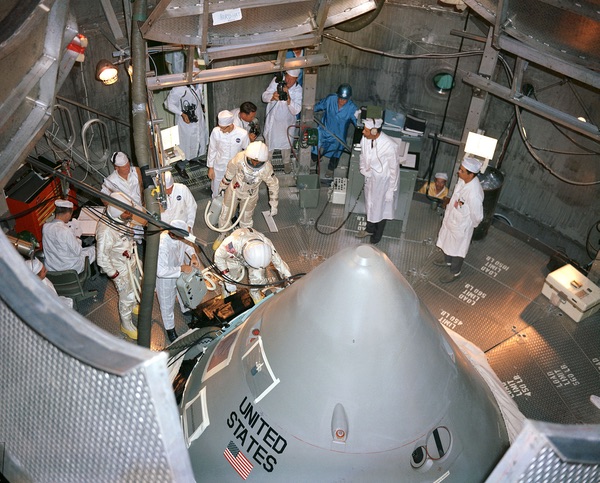 The Apollo 1 crew enters their spacecraft in a test in an altitude chamber at the Kennedy Space Center. (credit: NASA)
The Apollo 1 crew enters their spacecraft in a test in an altitude chamber at the Kennedy Space Center. (credit: NASA)In January 1967, three astronauts died on the ground in what should have been a routine test. Gus Grissom, Roger Chaffee, and Ed White were slated to launch into space in a few months aboard what was then known as Apollo 204 and would soon become known as Apollo 1. Following the fire, NASA conducted an internal investigation. The US Senate also held hearings and called senior NASA leaders to testify. One of the people at the hearings was NASA Deputy Administrator Robert Seamans, who appeared alongside NASA Administrator James Webb and head of the manned space flight office, George Mueller. They soon found themselves in the sights of a junior senator, Walter Mondale, who knew that there had been a string of problems involving Apollo main contractor North American Aviation. (See: “When Senator Walter Mondale went to the Moon: the Apollo 1 fire and the myths we create,” The Space Review, March 16, 2020.)
https://www.thespacereview.com/article/3904/149)
Capabilities on the cusp: the impact of a responsive, flexible launch challenge with no winnerby Todd Master Monday, March 23, 2020
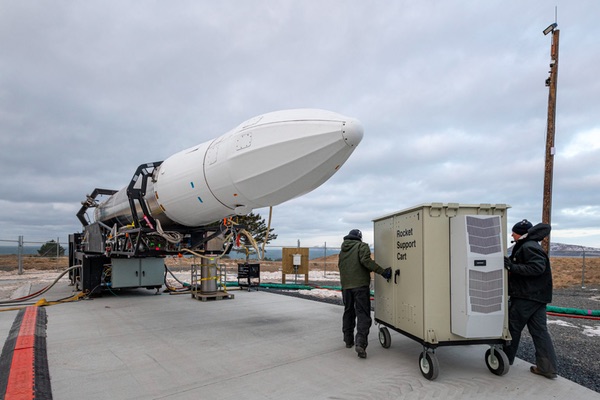 Astra prepares its Rocket 3.0 on a bare concrete pad in Kodiak, Alaska, prior to a launch attempt during the DARPA Launch Challenge. (credit: John Kraus/Astra)
Astra prepares its Rocket 3.0 on a bare concrete pad in Kodiak, Alaska, prior to a launch attempt during the DARPA Launch Challenge. (credit: John Kraus/Astra)Creating a flexible (“launch from anywhere”) and responsive (“launch any time”) space launch capability is a critical need for the Defense Department, with increasing importance as our views on national security space architectures evolve. Space resiliency is critical to our warfighting capability, and space access is its linchpin, as the means for deployment of our satellite systems. Resiliency for space access is directly created by untethering ourselves from one-of-a-kind fixed launch sites, which are subject to range congestion, weather, natural disasters, human-made disasters (like rockets blowing up on pads), and adversary attack. This resiliency is further bolstered by the ability to place in orbit new spacecraft at will, surging new on-orbit capability to provide tactical support to operations from space or rapidly replacing end-of-life, malfunctioning, or damaged spacecraft. Developing launch systems that deliver these capabilities is directly aligned with DARPA’s mission of preventing strategic surprise, and led us to DARPA Launch Challenge.
https://www.thespacereview.com/article/3905/150)
Space in uncertain timesby Jeff Foust Monday, March 23, 2020
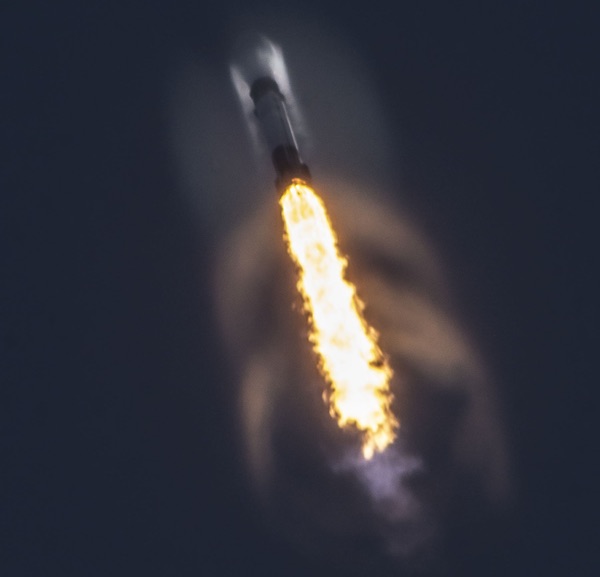 A SpaceX Falcon 9 after liftoff from the Kennedy Space Center March 18, a launch that went ahead despite the coronavirus pandemic. (credit: SpaceX)
A SpaceX Falcon 9 after liftoff from the Kennedy Space Center March 18, a launch that went ahead despite the coronavirus pandemic. (credit: SpaceX)Last month, even as the coronavirus epidemic was ravaging China and making inroads in other nations, the space industry’s concerns were elsewhere. There were debates about a NASA authorization bill in the House that would reshape NASA’s Artemis program even as the agency sought more money for it, the ongoing review into the flawed test flight of Boeing’s CST-100 Starliner commercial crew vehicle, renewed concerns about orbital debris after a close call between two defunct satellites, and discussions about the viability and sustainability of satellite constellations like OneWeb and SpaceX’s Starlink as both moved into full-scale deployment.
https://www.thespacereview.com/article/3906/1